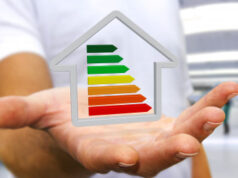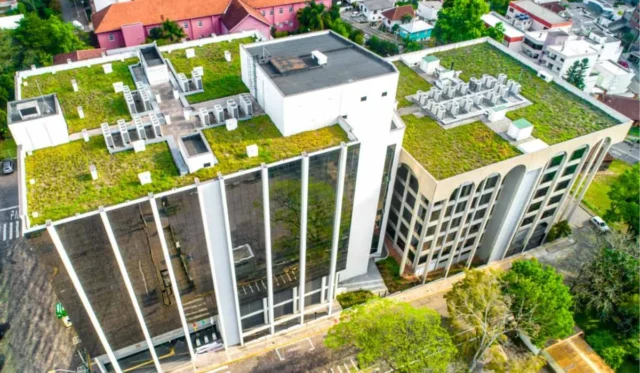
Green roofs and vertical gardens are becoming a refreshing breath of fresh air in our ever-evolving urban jungles. Picture this: Skyscrapers, instead of being cold, stark structures, teem with lush vegetation, and residential roofs are blanketed with gardens that touch the sky. It’s an enticing image, isn’t it? As you wander through this article, you’ll discover nine compelling arguments explaining why these green innovations are more than just aesthetic statements. They’re reshaping urban landscapes for the better.
1. Breathing Easy with Better Air Quality:
Cities often struggle with pollution, leading to what we commonly refer to as “smog.” Green roofs and vertical gardens act as natural air purifiers. Plants absorb carbon dioxide and release oxygen, making city air cleaner and more breathable. Over time, this could mean fewer respiratory issues and a healthier population.
2. Project Management Makes Implementation Seamless:

You might wonder how massive projects like transforming a skyscraper facade into a vertical garden are executed. This is where the top project management tools come into play. Coordinating such projects requires meticulous planning, resource allocation, and time management. With the best project management tools, the installation process becomes streamlined. These tools ensure that plants are appropriately chosen, resources are adequately utilized, and the garden or roof is maintained effectively post-installation.
3. A Natural Habitat in an Urban Setting:
Green roofs and vertical gardens create pockets of biodiversity in urban areas. They attract birds, bees, and butterflies, enhancing the ecosystem balance. This benefits the environment and enriches the urban experience for its residents, bringing a touch of nature to their daily lives.
4. An Effective Insulation Layer:
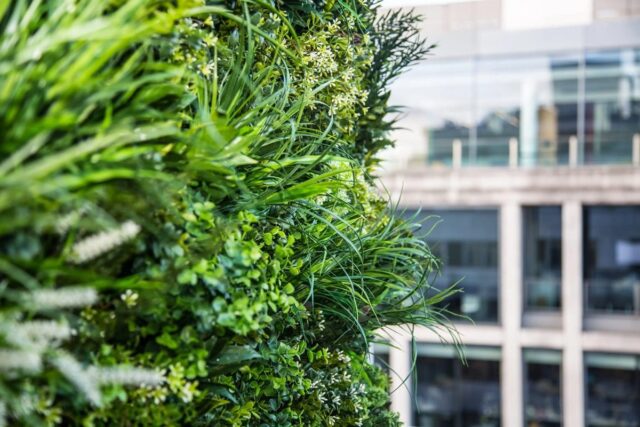
Such green installations act as natural insulators, reducing the need for artificial heating or cooling. During summers, they absorb sunlight, keeping buildings cooler. Conversely, in winter, they trap heat, reducing heating requirements. This thermal regulation leads to significant energy savings.
5. Stormwater Management:
Green roofs can absorb rainwater, reducing the runoff that often leads to city flooding. The plants and soil act as natural sponges, slowly releasing the water back into the environment or utilizing it for growth.
6. Noise Reduction:
Living in a city often means getting used to a certain level of noise pollution. The layers of soil and plants in green roofs and vertical gardens act as sound barriers, absorbing and reflecting the urban noise, making city life a tad quieter.
7. Aesthetic Enhancement and Recreational Spaces:
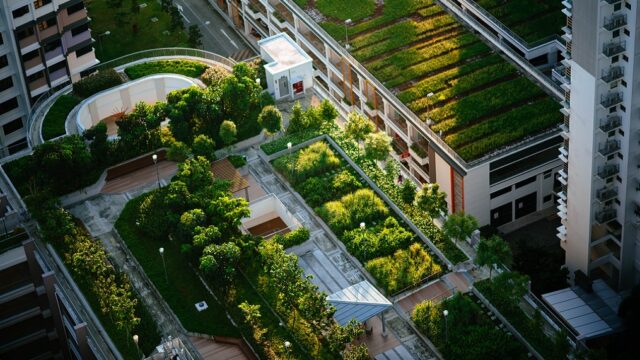
Beyond the practical benefits, let’s remember the sheer beauty of these green installations. They transform concrete facades into living artworks. Moreover, some green roofs are designed to be accessible, providing urban dwellers with serene recreational spots amidst the city hustle.
8. Boosting Property Value:
It’s not just about beauty and environment; it’s also about economics. Properties featuring green roofs or vertical gardens often see an increase in their value. They offer unique selling points in residential or commercial real estate.
9. Mental Well-being:
Being close to nature, even if it’s a mini-garden in a building, can profoundly affect mental health. Studies have shown that green spaces reduce stress, enhance mood, and improve concentration.
Additional Benefits of Green Roofs and Vertical Gardens:
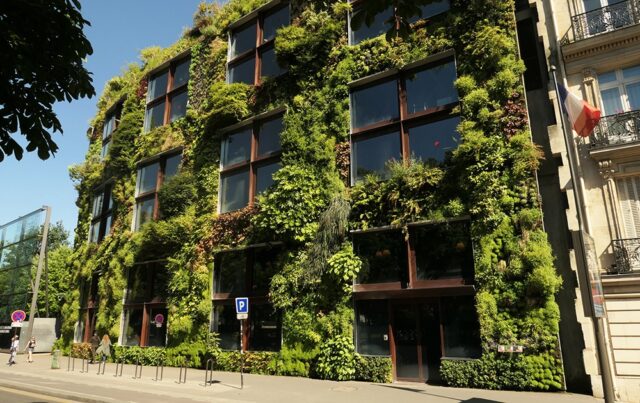
Microclimate Creation:
These green installations can form localized cooler areas, which is especially beneficial in urban heat islands.
Durability:
Green roofs can extend the lifespan of roofing materials by shielding the building material from UV rays and heavy rainfall.
Economic Benefits:
Cities that embrace green roofing and vertical gardening might see a rise in tourism. Visitors often appreciate and seek out environmentally-conscious destinations.
Education Opportunities:
Educational institutions in urban settings can use these spaces for hands-on learning about botany, ecology, and sustainability.
Food Production:
Some green roofs are designed as urban farms, providing fresh produce and reducing the need for transportation of goods.
Carbon Footprint Reduction:
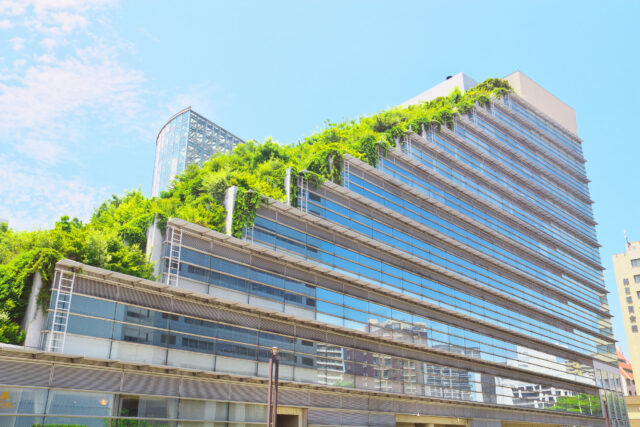
Plants naturally sequester carbon dioxide, making these installations crucial in combating increasing CO2 levels.
Social Spaces:
Green roofs can serve as community spaces, encouraging social interaction and providing venues for events.
Mindfulness and Relaxation:
In an ever-busy urban environment, such spaces offer a refuge for meditation, yoga, or simple relaxation.
Job Creation:
Enhancing Sustainability and Resilience:
In an era where sustainability is more than a buzzword, green roofs and vertical gardens stand out as practical solutions for enhancing urban resilience and sustainability. These green spaces contribute to the reduction of the urban heat island effect, wherein built-up areas tend to be hotter than nearby rural areas.
By providing shade and removing heat from the air through evapotranspiration, they cool the surrounding area, making cities more livable even in the face of climate change. Additionally, they add another layer of resilience by contributing to stormwater management, as they absorb rainwater, thus reducing the risk of flooding and erosion.
Green roofs and vertical gardens also contribute to biodiversity, providing habitats for various plants and animals, and thus helping to support urban ecosystems that have been disrupted by construction and urban expansion. They can be designed to support a variety of native plant species, which in turn attract native birds, insects, and other animals, promoting a balanced and diverse ecosystem even in the heart of a bustling city.
Enhancing Energy Efficiency:

Apart from their aesthetic appeal and environmental benefits, green roofs and vertical gardens also make a significant contribution to energy efficiency. The additional layer of insulation they provide reduces the energy consumption of buildings, leading to lower energy bills and reduced greenhouse gas emissions. During the summer, green roofs and vertical gardens keep buildings cooler by absorbing sunlight, thus reducing the need for air conditioning. In the winter, they help in retaining heat, thereby lowering heating costs.
Community and Wellness:
Beyond their environmental and economic benefits, green roofs and vertical gardens significantly contribute to community well-being. They offer peaceful, green spaces for residents and employees to relax, unwind, and connect with nature, even in the midst of a busy city.
Access to green spaces has been shown to have numerous health benefits, including reduced stress, improved mood, and enhanced mental well-being. They provide a much-needed oasis of calm and a place for social interaction, contributing to an improved quality of life and promoting a sense of community among city dwellers.
In Conclusion:
Green roofs and vertical gardens are far from just “pretty faces” of urban architecture. They’re powerful tools, backed by top project management methods, to make our cities more livable, breathable, and sustainable. As urban landscapes grow, integrating these green innovations becomes desirable and essential. So, the next time you’re in a city, look up! You can see a garden touching the sky.

